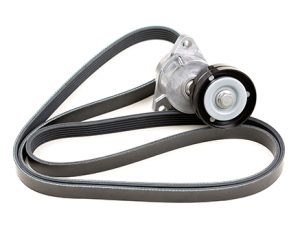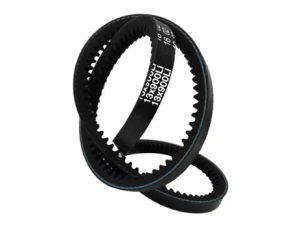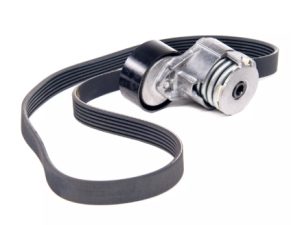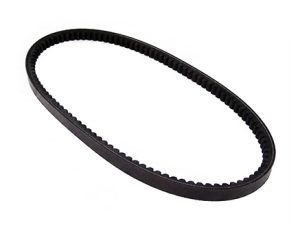Your car’s engine relies on several types of belts to keep everything running smoothly. These belts are crucial for transmitting power between engine components, ensuring that key systems operate correctly. In this post, we’ll break down the different types of belts in your car, their responsibilities, and when they should be replaced to avoid engine damage.
1. Serpentine Belt

The serpentine belt, also known as the drive belt, is the main belt in your engine. It’s a long, continuous belt that wraps around multiple pulleys and is responsible for powering accessories like the alternator, air conditioning compressor, power steering pump, and water pump.
What It Does:
- Transmits power from the engine’s crankshaft to other engine components.
- Ensures your vehicle’s accessories operate, including the electrical system and climate control.
When to Replace:
Typically lasts 60,000 to 100,000 miles, but it’s essential to inspect the belt regularly for signs of wear, cracks, or fraying.
Replace the belt immediately if you hear squealing or notice any power loss from the vehicle’s accessories.
2. V-Belts

V-belts are another type of engine belt commonly found in older vehicles. They have a “V” shape and are used to power specific components like the alternator, air conditioning, and power steering.
What It Does:
- Transfers power from the engine to components like the alternator, water pump, and power steering.
- Works in conjunction with pulleys to operate certain parts of the vehicle.
When to Replace:
V-belts should be checked for cracks, wear, or stretching around every 30,000 to 50,000 miles.
Replace the belt as soon as you notice visible signs of wear or hear any unusual noises, such as squeaking.
3. Auxiliary Belts

Auxiliary belts are secondary belts that drive additional components, such as the air conditioning compressor or the water pump. Some vehicles may have more than one auxiliary belt.
What It Does:
- Operates non-essential components that are not driven by the serpentine belt.
- Helps maintain the overall function of the engine and vehicle accessories.
When to Replace:
These belts typically need to be replaced every 60,000 to 100,000 miles, depending on the vehicle’s make and model.
Inspect for signs of wear and tear, such as cracks or fraying, especially if you hear any unusual sounds coming from the engine area.
4. Fan Belt

Fan belts are typically used to power the engine’s cooling fan and, in some cases, the air conditioning compressor. While they are becoming less common with modern engines, many older vehicles still rely on them.
What It Does:
- Powers the engine’s fan to keep the engine cool.
- In some cases, it also drives the air conditioning.
When to Replace:
Fan belts should be checked for cracks, wear, or slipping, and replaced every 40,000 to 60,000 miles.
If the engine begins to overheat or if the fan is not operating properly, the fan belt may be the culprit.
Importance of Regular Belt Maintenance
Car belts are integral to the proper functioning of your vehicle’s engine and accessories. If one belt fails, it can cause a domino effect of problems, leading to costly repairs. Regularly inspect your belts for any visible signs of wear, such as cracks, fraying, or glazing. Make sure to replace them at the recommended intervals to prevent engine failure or breakdowns.
Conclusion:
Knowing what belts are in your car’s engine and how they function is key to maintaining your vehicle’s health. Each belt plays an essential role in keeping your car running smoothly and ensuring its accessories work correctly. By staying proactive with belt inspections and replacements, you can avoid costly repairs and keep your car performing at its best. Be sure to consult your vehicle’s owner manual for specific guidelines on belt maintenance and replacement schedules. Always rely on a professional mechanic for inspections and replacements to ensure everything is in optimal condition.